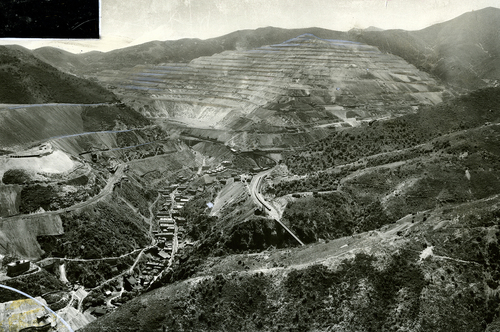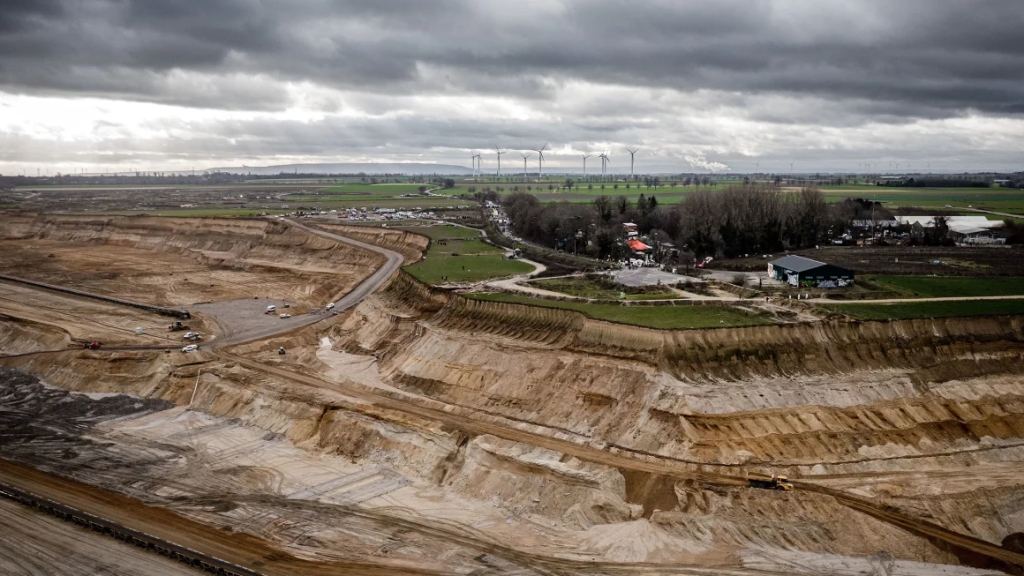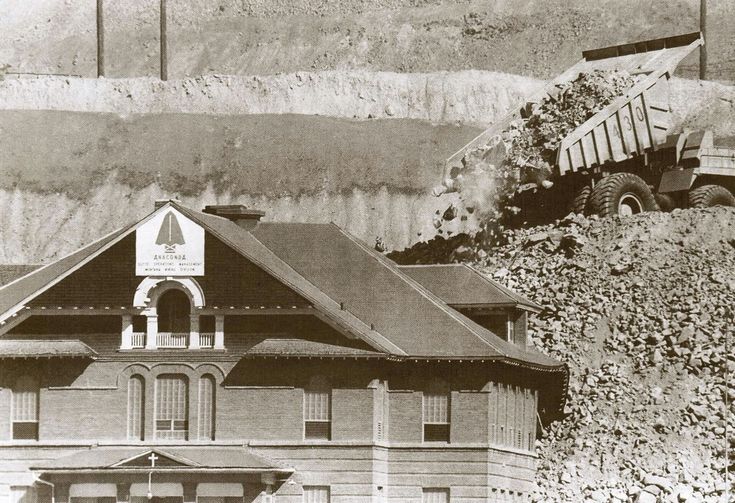There are many risks associated with mining. They may range from cave ins, to landslides, to fires, mechanical failures, explosions, and even flooding.

Image of Bingham, Utah in 1942 before the open pit mine reached the townsite – Source: archive.sltripbcom
One risk that may not be fully contemplated by workers and their families when a mine first opens is the potential for the mine to expand into areas not originally planned. This includes into the community itself where the miners and their families live, work, and play.

A related concern associated with underground mines in particular, is for the surface to subside (sink) as a result of all the material being removed from underground. Such sinking can damage or destroy homes, businesses, and infrastructure making it costly and risky to rebuild in the same location.
The following list identifies those known cities/towns that have experienced the trauma associated with their community being devoured by an expanding mine or have experienced serious amounts of subsidence.
Several other communities in Europe are facing uncertain futures due to mine expansions. These include Lützerath, Germany (see photo below) faces imminent destruction; Keyenberg and Kuckum, Germany in 2028; and Opolno-Zdrój in Poland.
As more places are identified, they will be added to this list. Peace!

Fully Devoured
Alice, Minnesota ( ca 1909-1921) – uniquely lost due to the relocation of Hibbing to Alice’s location when the local iron range mine expanded to engulf much of Hibbing’s original townsite
Bingham, Utah (1863-1972) – once had a population of 15,000, but was fully devoured by the Bingham Canyon Open Pit Mine
Eveleth, Minnesota (1893-1902) – original townsite location was moved as the mine expanded
Harold, Minnesota – lost to mine expansion
Immerath, Germany – abandoned and demolished for expansion of the Garzweiler II Coal Mine
Lavinia, Minnesota – lost to mine expansion
Leetonia, Minnesota – moved twice due to mine expansions
Lützerath, Germany – town is scheduled to be demolished for the expansion of the Garzweiler Coal Mine
Mahoning, Minnesota – lost to mine expansion
Malmberget, Sweden – the entire town was moved in 2020-2021 for mine expansion
McQueen, Montana (?-1970s) – devoured by the Berkeley Open Pit Mine

Meaderville, Montana (1880-1960s) – devoured by the Berkeley Open Pit Mine
Mercur, Utah (1890-1985) – ghost town that was devoured by the Mercur Open Pit Mine. The entire site has since been reclaimed since the mine closed in 1998.
Mineral Park, Arizona (1871-1912)- ruins lie within the Mineral Park Open Pit Mine property
Morenci, Arizona (1875-mid-1980s) – original townsite moved two miles so the Morenci Open Pit Mine could be expanded
Morris, Minnesota – lost to mine expansion
North Hibbing, Minnesota (Hibbing’s original townsite from 1893-1921)- lost to mine expansion with approximately 200 structures moved two miles south between 1919 and 1921

Old Manheim, Germany – being replaced by New Manheim – one of 50 small towns and villages lost to coal mining in the area. Unfortunately a list of all 50 has not been found.
Penobscot, Minnesota – lost to mine expansion
Pillsbury, Minnesota – lost to mine expansion
Poole, Minnesota – lost to mine expansion
Ray, Arizona (1909- 1950s) – devoured by the Ray Open Pit Mine
Ruth, Nevada (1903-1950s) – devoured by the Liberty Open Pit Mine (part of the Robinson Mine)
Sonora, Arizona (1912-1950s?) – devoured by the Ray Open Pit Mine
Santa Rita, New Mexico (1803-1967) – devoured by the Santa Rita (Chino) Open Pit Mine
Sparta, Minnesota (1896-1911) – conversion of the Genoa and Sparta Mines from underground to open pit lead to the loss of this town
Webb, Minnesota – lost to mine expansion
Wollar, NSW, Australia – swallowed up except one property by Wilpinjong Open Pit Mine
_______
Partially Devoured
Bitterfeld, Germany – several neighborhoods lost to coal mining
Butte, Montana( ?-1973) – east side of town lost to the Berkeley Open Pit Mine. Some of the structures were moved to the south side of town. Also lost was the Columbia Gardens Amusement Park and parts of the Dublin Gulch and Finntown neighborhoods.
Cerro de Pasco, Peru – unckear how much of the town has been lost
Kolwezi, Democratic Republic of the Congo – Cité Gécamines neighborhood is being lost to the expansion of cobalt and copper mines in the area
Lead, South Dakota – portions town that were at the bottom of the canyon were moved in the 1930s due to fear of cave-ins from then underground portions the Homestake Mine. Other poretions of the town were moved to expand the Homestake Open Pit Mine.
“In addition to providing jobs, the mine had a physical impact on Lead. As the mine expanded and the Open Cut grew, the town was moved. Partly dug by man, and partly created by subsidence, the Open Cut began devouring Lead City as early as 1895, and in 1911, part of Gold Street plunged down 300 feet. Over the years the Open Cut swallowed various parts of town. According to Irma Klock in LEAD CITY, ‘This is what has given the city its restless designation – it hasn’t stayed put as do most towns.”
Source: westernmininghistory.com
Terraville, South Dakota (1880-1980s) – devoured by the Homestake Open Pit Mine
_______
Lost to subsidence

Diamond City, Montana (1864-?) – now a ghost town
Kiruna, Sweden – original townsite is being lost and a new one is being built about 2.5 miles away due to subsidence from mining
Malmberget, Sweden – prior to moving the town a large sinkhole developed in the middle of the town
Mansfield, Victoria, Australia – areas of subsidence due to coal mining
Saltdale, California (1914-1975) – sinking/decaying into the salt brine its residents mined
SOURCES:
- https://www.theguardian.com/world/2023/feb/05/why-a-swedish-town-is-on-the-move-one-building-at-a-time-kirkuna-arctic-circle
- https://www.dnr.state.mn.us/education/geology/digging/history.html
- https://www.mnopedia.org/event/relocation-hibbing-1919-1921
- https://www.nationalgeographic.com/history/article/151202-Cerro-de-Pasco-Peru-Volcan-mine-eats-city-environment
- https://www.vice.com/en/article/7b7y5e/pit-city-0000464-v21n10
- https://www.eenews.net/articles/german-villages-in-path-of-coal-mine-turn-into-ghost-towns/
- https://en.wikipedia.org/wiki/Santa_Rita,_New_Mexico
- https://www.azcentral.com/story/news/local/arizona-best-reads/2016/07/13/fifty-years-and-rebuilt-town-later-morenci-remembers-its-nine/86711650/
- https://en.wikipedia.org/wiki/Berkeley_Pit
- https://www.hmdb.org/m.asp?m=186108
- https://www.kxlf.com/news/local-news/documentary-in-the-works-about-the-destruction-of-two-towns-in-butte
- https://en.wikipedia.org/wiki/Lead%2C_South_Dakota
- https://bringmethenews.com/life/places-to-visit-in-minnesota-the-eerie-ghost-town-of-north-hibbing
- https://www.bbc.com/future/article/20210419-the-end-of-the-worlds-capital-of-brown-coal
- https://www.theguardian.com/environment/2021/may/02/im-not-selling-what-happens-when-an-australian-town-is-consumed-by-a-us-coalminer
- https://www.hcn.org/articles/sightseeing-at-an-open-pit-mine/
- https://westernmininghistory.com/towns/arizona/ray/
- https://en.wikipedia.org/wiki/Mineral_Park_mine
- https://en.wikipedia.org/wiki/Sonora,_Arizona
- https://www.ghosttowns.com/states/az/sonora.html
- https://westernmininghistory.com/towns/south-dakota/lead/
- https://westernmininghistory.com/towns/south-dakota/terraville/
- https://westernmininghistory.com/towns/utah/bingham/
- https://westernmininghistory.com/towns/utah/mercur/
- https://westernmininghistory.com/towns/montana/diamond-city/
- https://www.sfgate.com/travel/article/saltdale-ghost-town-vanishing-18591851.php
- https://www.vvdailypress.com/story/lifestyle/2022/02/03/california-mojave-desert-ghost-towns-exploring-saltdale-salt-flats-netflix-worthy-travel-destination/9305051002/
- https://www.nevadaappeal.com/news/2004/dec/21/ruth-old-mining-town-now-swallowed-up-by-pit-mine/
- https://en.wikipedia.org/wiki/Robinson_Mine
- gemini.google.com
- perplexity.ai
- https://westernmininghistory.com/towns/montana/butte/
- https://mesabitrail.com/trail-towns/sparta/
- https://hibbinghistory.org/wp-content/uploads/2020/03/Hull-Rust-OVERLOOK-13453.jpg
- https://www.pbs.org/video/minnesotas-lost-mining-towns-fywyiw/
- https://en.wikipedia.org/wiki/Eveleth,_Minnesota
- https://www.cnn.com/2023/01/14/europe/lutzerath-germany-coal-protests-climate-intl/index.html
- https://www.mnopedia.org/event/relocation-hibbing-1919-1921
- https://en.wikipedia.org/wiki/Malmberget
